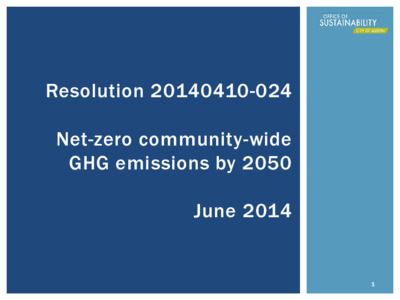Item 2: Presentation from the Sustainability Office — original pdf
Backup

Resolution 20140410-024 Net-zero community-wide GHG emissions by 2050 June 2014 1 Resolution 20140410-024 Emission Sources and Goals Process and Plan Agenda 2 Council established goal: Net-zero community-wide greenhouse gas emissions by 2050 Prefers to achieve as soon as feasible Emission reductions accomplished sooner are more important Review goals & objectives in 2007 Climate resolution Recommend: Measurable interim targets starting with 2020, periodically to 2050 How and when annual progress reports will occur How often to conduct comprehensive updates to the climate plan Council Resolution 3 Council resolution timeline 1.Framework – May - September 2014 a)Interim targets b)Framework for meeting targets c)Progress update to City Council 2.Final Plan – October 2014 - March 2015 a)Focused actions and reduction calculations b)Combine emission reductions and climate resiliency into one comprehensive plan document c)Presented for Community review and council adoption 3.Implementation Plan a)Specific actions b)Costs and schedules c)Data tracking 4 Resolution 20140410-024 Energy Power plants in and outside of Travis county Natural gas burned for heat Transportation CAMPO estimates of Travis County vehicle miles traveled scaled to an annual basis Waste & manufacturing Wastewater, landfills, cement manufacturing, and semiconductor PFCs 2010 Travis County GHG Inventory 15.2 Million metric tons CO2e 5 Developed using the ICLEI U.S. Community GHG Protocol, 2012 Growth v. Goal 6 Public Input Sessions Reviewed by Relevant Boards and Commissions Consideration of results of 2014 Generation Plan Task Force Formation of Technical Advisory Groups to work with city staff to develop action plans Stakeholder Process 7 Community Climate Steering Committee Energy Technical Advisory Group Transportation Technical Advisory Group Waste Technical Advisory Group Industry Technical Advisory Group Organization 8 TAG Purpose: Create and distill the strategies, actions, and sub-measures for each sector Sector plans should include GHG emissions resulting from existing plans Short & long term actions Secondary goals & measures for sector specific factors (VMT, renewables, etc.) Feasibility & how other sectors could make up for shortfalls Take into account Population and business growth Available and emerging technology Potential costs and benefits Climate preparedness and resilience Barriers where the City does not exert direct control over community emissions Technical Advisory Group Action Plans 9 May – Planning Departmental briefings, setup, and participant identification June – Kicking Off Late June kickoff meeting with all stakeholders July – Initial Work TAGs defining boundaries and overarching strategies Steering Committee defining boundaries and reviewing targets August – Progress Strategies, actions, goals defined and beginning qualitative assessment September – Present and Move to Phase II Framework and progress report to Council Near term schedule 10 Questions? 11